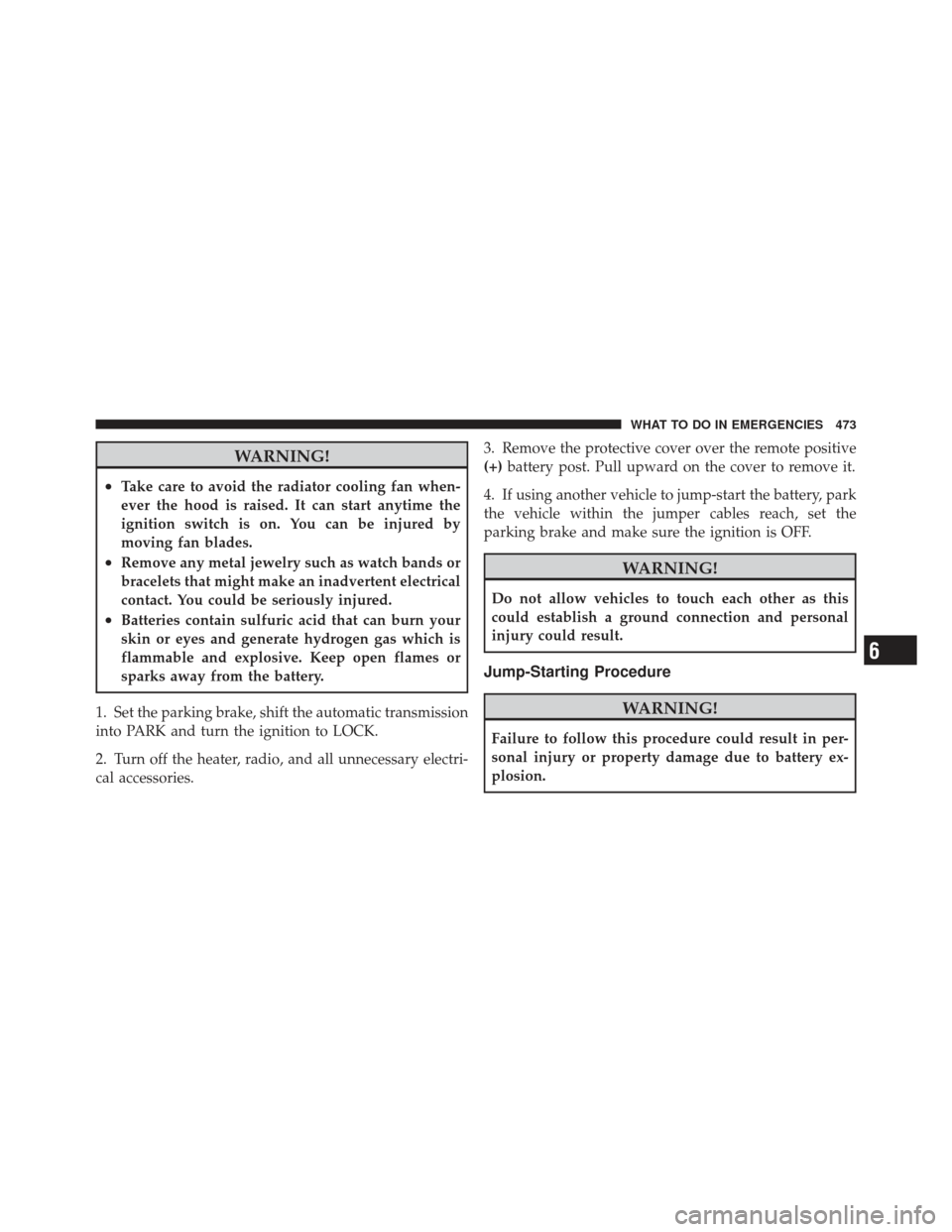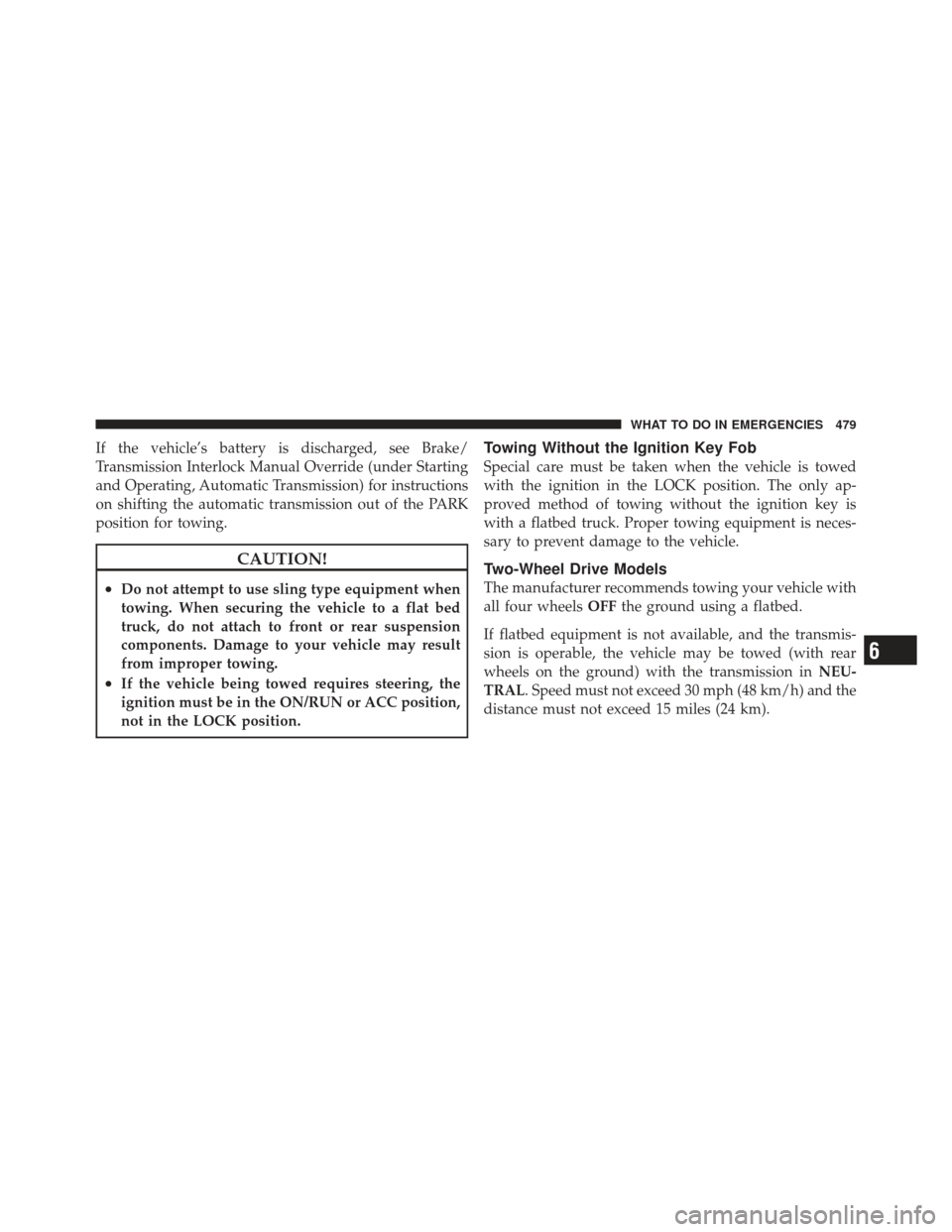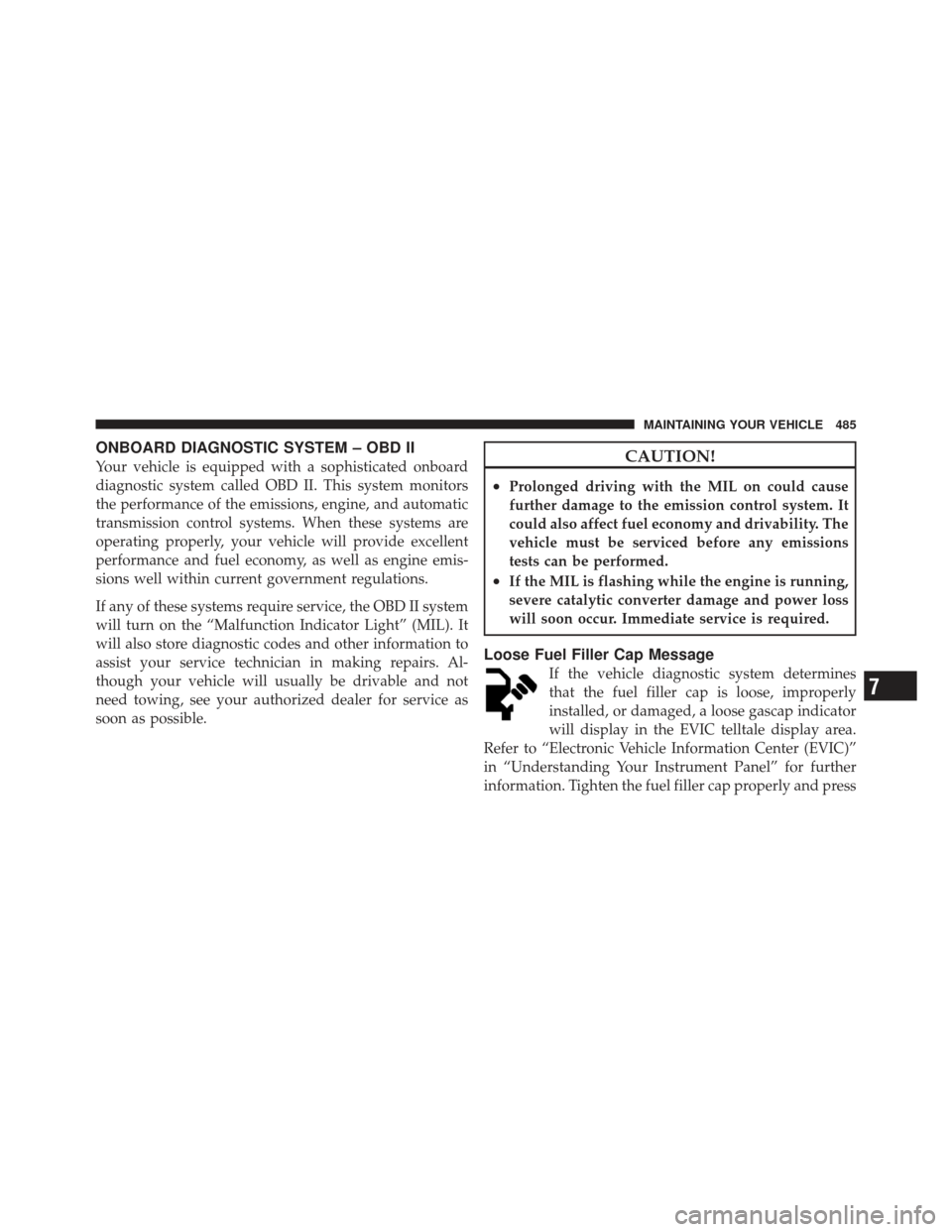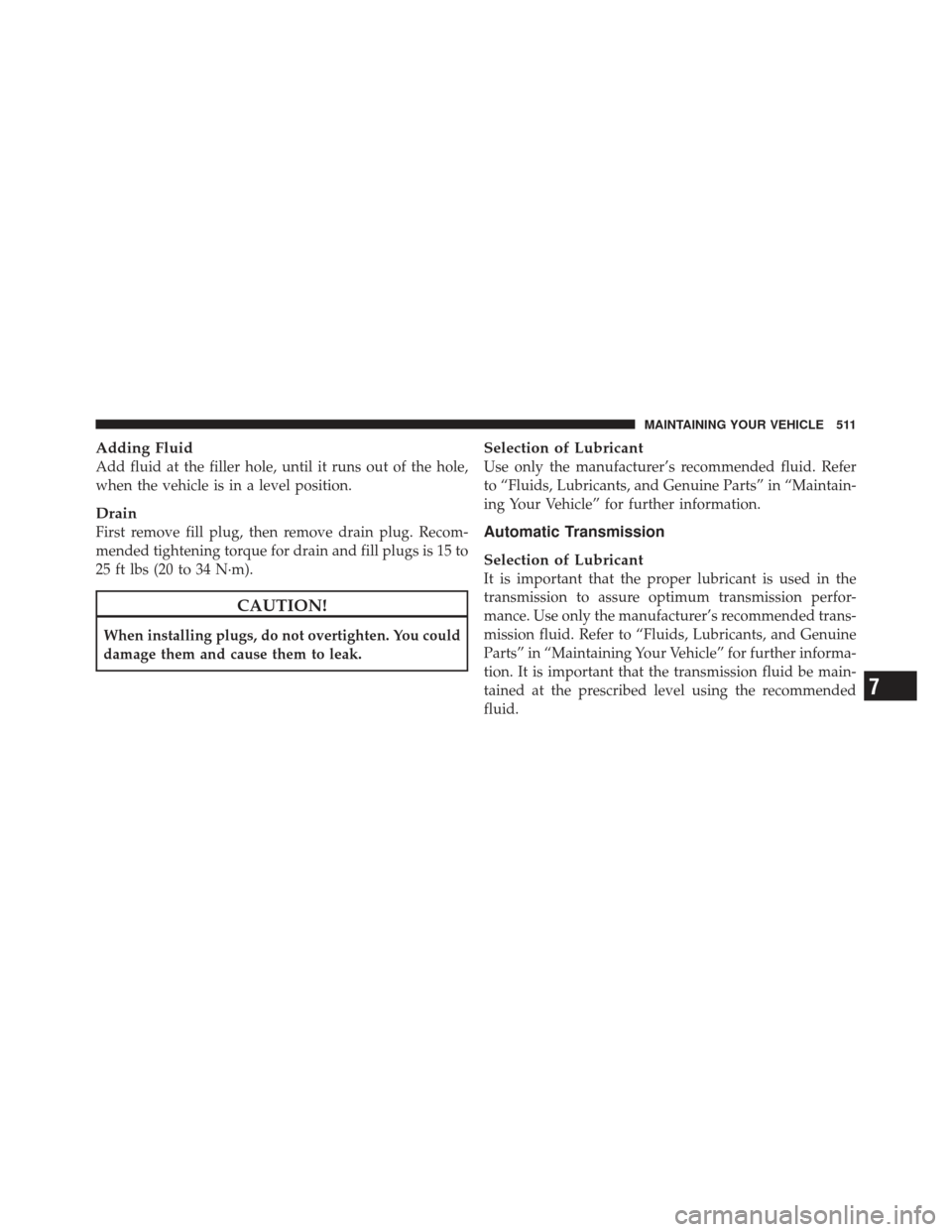Page 455 of 587
RECREATIONAL TOWING (BEHIND MOTORHOME, ETC.)
Towing This Vehicle Behind Another Vehicle
Towing Condition Wheel OFF theGroundTwo-Wheel Drive
Models Four-Wheel Drive Models
Flat Tow NONENOT ALLOWED See Instructions
•Transmission in PARK
•Transfer case in NEUTRAL (N)
•Tow in forward direction
Dolly Tow Front
NOT ALLOWED NOT ALLOWED
Rear OK NOT ALLOWED
On Trailer ALLOK OK
NOTE:Vehicles equipped with Quadra-Lift™ must be lowered to the “Park” (lowest) level, and have automatic
leveling disabled, before tying them down (from the body) on a trailer or flatbed truck. Refer to “Quadra-Lift™
– If Equipped” in “Starting and Operating” for more information. If the vehicle cannot be lowered to the “Park”
level (for example, engine will not run), tie-downs must be fastened to the axles (not to the body). Failure to
follow these instructions may cause fault codes to be set and/or loss of proper tie-down tension.5
STARTING AND OPERATING 453
Page 468 of 587
Jacking Instructions
WARNING!
Carefully follow these tire changing warnings to
help prevent personal injury or damage to your
vehicle:
•Always park on a firm, level surface as far from
the edge of the roadway as possible before raising
the vehicle.
•Turn on the Hazard Warning flasher.
•Block the wheel diagonally opposite the wheel to
be raised.
•Set the parking brake firmly and set an automatic
transmission in PARK.
•Never start or run the engine with the vehicle on a
jack.(Continued)
WARNING! (Continued)
•Do not let anyone sit in the vehicle when it is on a
jack.
•Do not get under the vehicle when it is on a jack.
•Only use the jack in the positions indicated and
for lifting this vehicle during a tire change.
•If working on or near a roadway, be extremely
careful of motor traffic.
•To assure that spare tires, flat or inflated, are
securely stowed, spares must be stowed with the
valve stem facing the ground.
Jack Warning Label
466 WHAT TO DO IN EMERGENCIES
Page 475 of 587

WARNING!
•Take care to avoid the radiator cooling fan when-
ever the hood is raised. It can start anytime the
ignition switch is on. You can be injured by
moving fan blades.
•Remove any metal jewelry such as watch bands or
bracelets that might make an inadvertent electrical
contact. You could be seriously injured.
•Batteries contain sulfuric acid that can burn your
skin or eyes and generate hydrogen gas which is
flammable and explosive. Keep open flames or
sparks away from the battery.
1. Set the parking brake, shift the automatic transmission
into PARK and turn the ignition to LOCK.
2. Turn off the heater, radio, and all unnecessary electri-
cal accessories. 3. Remove the protective cover over the remote positive
(+)
battery post. Pull upward on the cover to remove it.
4. If using another vehicle to jump-start the battery, park
the vehicle within the jumper cables reach, set the
parking brake and make sure the ignition is OFF.
WARNING!
Do not allow vehicles to touch each other as this
could establish a ground connection and personal
injury could result.
Jump-Starting Procedure
WARNING!
Failure to follow this procedure could result in per-
sonal injury or property damage due to battery ex-
plosion.
6
WHAT TO DO IN EMERGENCIES 473
Page 481 of 587

If the vehicle’s battery is discharged, see Brake/
Transmission Interlock Manual Override (under Starting
and Operating, Automatic Transmission) for instructions
on shifting the automatic transmission out of the PARK
position for towing.
CAUTION!
•Do not attempt to use sling type equipment when
towing. When securing the vehicle to a flat bed
truck, do not attach to front or rear suspension
components. Damage to your vehicle may result
from improper towing.
•If the vehicle being towed requires steering, the
ignition must be in the ON/RUN or ACC position,
not in the LOCK position.
Towing Without the Ignition Key Fob
Special care must be taken when the vehicle is towed
with the ignition in the LOCK position. The only ap-
proved method of towing without the ignition key is
with a flatbed truck. Proper towing equipment is neces-
sary to prevent damage to the vehicle.
Two-Wheel Drive Models
The manufacturer recommends towing your vehicle with
all four wheelsOFFthe ground using a flatbed.
If flatbed equipment is not available, and the transmis-
sion is operable, the vehicle may be towed (with rear
wheels on the ground) with the transmission in NEU-
TRAL. Speed must not exceed 30 mph (48 km/h) and the
distance must not exceed 15 miles (24 km).
6
WHAT TO DO IN EMERGENCIES 479
Page 484 of 587

▫Brake System ....................... 507
▫ Front/Rear Axle Fluid ................. 509
▫ Transfer Case ....................... 510
▫ Automatic Transmission ............... 511
▫ Appearance Care And Protection From
Corrosion .......................... 515
� Fuses .............................. 520
▫ Totally Integrated Power Module ......... 520
� Vehicle Storage ....................... 525
� Replacement Bulbs .................... 526
� Bulb Replacement ..................... 527
▫ High Intensity Discharge Headlamps (HID) –
If Equipped ........................ 527 ▫
Halogen Headlamps – If Equipped ........ 527
▫ Front Turn Signal .................... 528
▫ Front Fog Lamps .................... 528
▫ Rear Tail, Stop, Turn Signal, And Backup
Lamps ............................ 530
▫ Rear Liftgate Mounted Tail Lamp ......... 531
▫ Center High-Mounted Stop Lamp
(CHMSL) .......................... 532
▫ Rear License Lamp ................... 532
� Fluid Capacities ...................... 533
� Fluids, Lubricants, And Genuine Parts ....... 534
▫ Engine ............................ 534
▫ Chassis ........................... 535
482 MAINTAINING YOUR VEHICLE
Page 486 of 587
ENGINE COMPARTMENT – 5.7L
1 — Totally Integrated Power Module (Fuses)6 — Washer Fluid Reservoir
2 — Automatic Transmission Dipstick 7 — Engine Oil Dipstick
3 — Engine Oil Fill 8 — Coolant Pressure Cap (Radiator)
4 — Brake Fluid Reservoir 9 — Engine Coolant Reservoir
5 — Air Cleaner Filter
484 MAINTAINING YOUR VEHICLE
Page 487 of 587

ONBOARD DIAGNOSTIC SYSTEM – OBD II
Your vehicle is equipped with a sophisticated onboard
diagnostic system called OBD II. This system monitors
the performance of the emissions, engine, and automatic
transmission control systems. When these systems are
operating properly, your vehicle will provide excellent
performance and fuel economy, as well as engine emis-
sions well within current government regulations.
If any of these systems require service, the OBD II system
will turn on the “Malfunction Indicator Light” (MIL). It
will also store diagnostic codes and other information to
assist your service technician in making repairs. Al-
though your vehicle will usually be drivable and not
need towing, see your authorized dealer for service as
soon as possible.CAUTION!
•Prolonged driving with the MIL on could cause
further damage to the emission control system. It
could also affect fuel economy and drivability. The
vehicle must be serviced before any emissions
tests can be performed.
•If the MIL is flashing while the engine is running,
severe catalytic converter damage and power loss
will soon occur. Immediate service is required.
Loose Fuel Filler Cap Message
If the vehicle diagnostic system determines
that the fuel filler cap is loose, improperly
installed, or damaged, a loose gascap indicator
will display in the EVIC telltale display area.
Refer to “Electronic Vehicle Information Center (EVIC)”
in “Understanding Your Instrument Panel” for further
information. Tighten the fuel filler cap properly and press
7
MAINTAINING YOUR VEHICLE 485
Page 513 of 587

Adding Fluid
Add fluid at the filler hole, until it runs out of the hole,
when the vehicle is in a level position.
Drain
First remove fill plug, then remove drain plug. Recom-
mended tightening torque for drain and fill plugs is 15 to
25 ft lbs (20 to 34 N·m).
CAUTION!
When installing plugs, do not overtighten. You could
damage them and cause them to leak.
Selection of Lubricant
Use only the manufacturer’s recommended fluid. Refer
to “Fluids, Lubricants, and Genuine Parts” in “Maintain-
ing Your Vehicle” for further information.
Automatic Transmission
Selection of Lubricant
It is important that the proper lubricant is used in the
transmission to assure optimum transmission perfor-
mance. Use only the manufacturer’s recommended trans-
mission fluid. Refer to “Fluids, Lubricants, and Genuine
Parts” in “Maintaining Your Vehicle” for further informa-
tion. It is important that the transmission fluid be main-
tained at the prescribed level using the recommended
fluid.
7
MAINTAINING YOUR VEHICLE 511